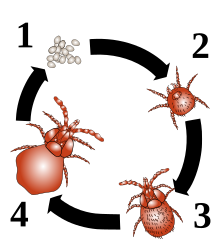Autumn mite
| Autumn grass mite | ||||||||||||
|---|---|---|---|---|---|---|---|---|---|---|---|---|

Larva of the autumn grass mite |
||||||||||||
| Systematics | ||||||||||||
|
||||||||||||
| Scientific name | ||||||||||||
| Neotrombicula autumnalis | ||||||||||||
| ( Shaw , 1790) |
The autumn mite or harvest mite ( Neotrombicula autumnalis ) belongs to the class of arachnids , therein to the subclass of mites and therein to the family of running mites . Their larvae live parasitically like those of many other running mites ; they mainly attack mice, but also dogs, house cats and other mammals and, on occasion, humans.
The autumn mite is also often referred to as the autumn grass mite , hay mite or grass mite , but it has nothing to do with the grass mites that suckle on plants. Even common names such as grass louse , ground louse or peach louse are misleading in that the fully grown eight-legged mites are not closely related to the six-legged lice that belong to the insects. The (six-legged) larvae of the autumn mite cause harvest scabies in humans , also called autumn bite or trombidiosis .
distribution
Autumn grass mites are common all over the world. In the northern hemisphere, depending on the location and subspecies or weather conditions, they occur from April to late October, and in the southern hemisphere from November to March. In Europe, the focus of occurrence is usually in the summer months from July to October. They prefer low vegetation and are common in gardens or meadows.
proof
The larvae can hardly be seen with the naked eye; a piece of white paper that is laid out attracts the animals and reveals their presence.
features
The larvae are up to 0.3 millimeters in size and orange-red in color. They have a broad back shield and two double eyes. The adult mites are about 2 millimeters in size.
Life cycle
After about four weeks, the mite larvae hatch from the eggs laid on the ground. In warm, humid and sunny weather, they climb cushions of moss and blades of grass and wait for a potential host at a height of 5 to 20 cm. They can be stripped from low vegetation by birds and mammals, especially small rodents, but also dogs, cats and humans, or switch to them quickly. On the host's skin, they look for warm, moist areas with a thin cornea, scratch the skin with their mouthparts and secrete salivary secretions that loosen the tissue. They feed on cell juices and lymph . They rarely injure a capillary and thus absorb blood. After sucking, which lasts only a few hours in humans and in other animal hosts up to several days, they drop off and develop over three nymph stages into adult animals that do not parasitize on the ground and overwinter there.
Harmful effect
Autumn mites cause harvest scabies (hay scabies, autumn bites, etc.) or gooseberry disease in humans . The symptoms (referred to as bite , among other things ) arise no later than 24 hours after the larvae have fallen off, but often after a few hours. Preferred places are warm areas of the body and skin folds as well as places under tight-fitting clothing. Itching, reddening of the skin and itchy wheals (similar to mosquito bites, but in larger numbers) occur. Warmth in the bed in the first few hours increases the harmful effect. The symptoms subside spontaneously after about 10-14 days.
The mites also cause malaise and itching in animals.
prevention
Rubbing in repellants , which with their fragrances drive away mosquitoes and other insects, is supposed to keep the mite larvae away. After exposure, a cool shower helps relieve itching.
Web links
literature
- Journal of general medicine: Trombiculiden und Trombidiose (2000) (PDF file; 103 kB)
- Studies on the biology and ecology of the autumn mite, dissertation Univ. Bonn, 2003 (PDF file; 3.60 MB)
swell
- ↑ Health information on autumn grass mite ( Memento of the original from March 4, 2016 in the Internet Archive ) Info: The archive link was inserted automatically and has not yet been checked. Please check the original and archive link according to the instructions and then remove this notice. on the website of the Rhein-Erft-Kreis. Retrieved September 11, 2016.
- ^ Richard Wall & David Shearer: Trombiculidae . In: Veterinary Ectoparasites: Biology, Pathology, and Control , 2nd. Edition, John Wiley and Sons , 2001, ISBN 978-0-632-05618-7 , pp. 47-48.
- ↑ Information sheet for autumn mites (pdf) from the Baden-Württemberg State Health Office, 2010.

